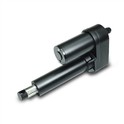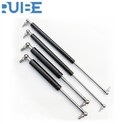In the realm of furniture engineering, sofa gas springs play a pivotal role in enhancing the functionality and comfort of sofas. As a seasoned supplier of Sofa Gas Springs, I often encounter inquiries about various technical aspects of these components, with the damping ratio being a frequently asked question. In this blog post, I aim to demystify the concept of the damping ratio of a sofa gas spring, exploring its significance, influencing factors, and practical implications.
Understanding the Basics of Gas Springs
Before delving into the damping ratio, it's essential to have a basic understanding of what a gas spring is. A gas spring is a type of mechanical device that uses compressed gas (usually nitrogen) to provide force and support. In the context of sofas, gas springs are commonly used to assist in the opening and closing of sofa beds, reclining mechanisms, and other movable parts. They offer a smooth and controlled motion, making it easier for users to adjust the position of the sofa.
The main components of a gas spring include a cylinder, a piston rod, and a valve. The cylinder is filled with compressed gas, and the piston rod moves inside the cylinder. When a force is applied to the piston rod, the gas is compressed, and the spring provides a counterforce. The valve controls the flow of gas, which affects the speed and smoothness of the motion.
What is the Damping Ratio?
The damping ratio is a crucial parameter that describes the behavior of a gas spring during its operation. It is defined as the ratio of the actual damping coefficient of the gas spring to the critical damping coefficient. In simpler terms, the damping ratio determines how quickly a gas spring returns to its equilibrium position after being displaced.
A damping ratio of 0 means that there is no damping, and the gas spring will oscillate indefinitely after being displaced. On the other hand, a damping ratio of 1 represents critical damping, where the gas spring returns to its equilibrium position in the shortest possible time without oscillating. A damping ratio greater than 1 indicates overdamping, where the gas spring returns to its equilibrium position slowly, while a damping ratio between 0 and 1 represents underdamping, where the gas spring oscillates before coming to rest.
Significance of the Damping Ratio in Sofa Gas Springs
In the context of sofas, the damping ratio of a gas spring has several important implications. Firstly, it affects the user experience. A gas spring with an appropriate damping ratio will provide a smooth and controlled motion when opening or closing a sofa bed or adjusting the reclining position. This not only enhances the comfort of the user but also reduces the risk of sudden movements that could cause injury.
Secondly, the damping ratio can impact the durability of the sofa. A gas spring with excessive damping may cause unnecessary stress on the sofa's frame and other components, leading to premature wear and tear. Conversely, a gas spring with insufficient damping may result in excessive vibrations and impacts, which can also damage the sofa over time.
Finally, the damping ratio can influence the overall performance of the sofa. For example, in a sofa bed, a gas spring with the right damping ratio can ensure that the bed opens and closes smoothly, without getting stuck or making loud noises. This can improve the functionality of the sofa and make it more appealing to consumers.


Factors Affecting the Damping Ratio
Several factors can influence the damping ratio of a sofa gas spring. One of the most significant factors is the design of the gas spring itself. The size and shape of the cylinder, the diameter of the piston rod, and the type of valve used can all affect the damping characteristics of the gas spring.
Another important factor is the gas pressure inside the cylinder. Higher gas pressure generally results in a higher damping ratio, as the gas provides more resistance to the movement of the piston rod. However, excessive gas pressure can also cause the gas spring to become too stiff, which may affect its performance.
The temperature can also have an impact on the damping ratio. As the temperature increases, the gas inside the cylinder expands, which can reduce the damping ratio. Conversely, lower temperatures can cause the gas to contract, increasing the damping ratio.
Finally, the load applied to the gas spring can affect its damping ratio. A heavier load will generally require a higher damping ratio to ensure a smooth and controlled motion.
Measuring the Damping Ratio
Measuring the damping ratio of a sofa gas spring requires specialized equipment and expertise. One common method is to use a dynamic testing machine, which can apply a known force to the gas spring and measure its response. By analyzing the displacement and velocity of the piston rod over time, the damping ratio can be calculated.
Another method is to use a vibration testing system, which can measure the natural frequency and damping ratio of the gas spring by exciting it with a small vibration. This method is often used in research and development to optimize the design of gas springs.
Choosing the Right Damping Ratio for Your Sofa
When selecting a sofa gas spring, it's important to choose one with the appropriate damping ratio for your specific application. The ideal damping ratio will depend on several factors, including the type of sofa, the expected load, and the desired user experience.
For a sofa bed, a damping ratio between 0.2 and 0.5 is generally recommended. This will provide a smooth and controlled motion when opening and closing the bed, without excessive oscillations. For a reclining sofa, a slightly higher damping ratio of around 0.5 to 0.7 may be more suitable, as it will ensure a stable and comfortable reclining position.
It's also important to consider the quality and reliability of the gas spring. Look for a reputable supplier who offers high-quality gas springs that are designed and tested to meet industry standards. A reliable supplier will also be able to provide technical support and advice to help you choose the right gas spring for your needs.
Our Sofa Gas Springs
As a leading supplier of Sofa Gas Springs, we offer a wide range of products with different damping ratios to meet the diverse needs of our customers. Our gas springs are designed and manufactured using the latest technology and high-quality materials to ensure superior performance and durability.
We also provide customized solutions to meet the specific requirements of our customers. Whether you need a gas spring with a specific damping ratio, load capacity, or stroke length, our team of experts can work with you to develop a tailored solution that meets your needs.
If you're interested in learning more about our Sofa Gas Springs or have any questions about the damping ratio, please visit our website Sofa Gas Spring. You can also explore our other products, such as Gas Spring for Office Chair and Lockable Gas Spring for Desk.
Contact Us for Procurement
If you're in the market for high-quality sofa gas springs, we invite you to contact us for procurement discussions. Our team of sales representatives is ready to assist you in selecting the right gas springs for your sofas and providing you with competitive pricing and excellent customer service. Whether you're a furniture manufacturer, a retailer, or an individual looking for a reliable gas spring supplier, we're here to meet your needs.
References
- Mechanical Engineering Handbook, edited by Myer Kutz
- Gas Spring Design and Application Guide, published by Suspa Inc.
- Research papers on gas spring dynamics and damping characteristics from academic journals such as the Journal of Mechanical Design.






